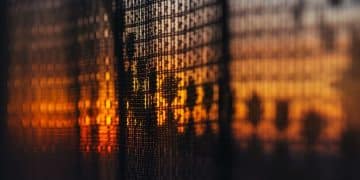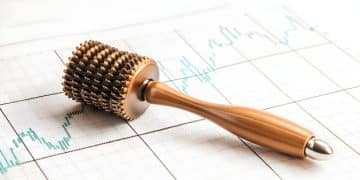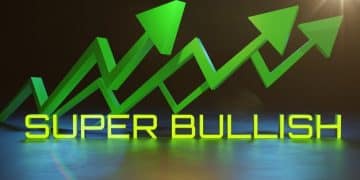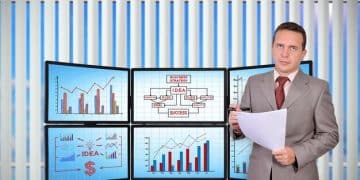New Federal Reserve Policy: What 0.25% Rate Hike Means for Consumers

The Federal Reserve’s anticipated 0.25% interest rate hike signals a tightening of monetary policy, aiming to curb inflation but potentially impacting consumer borrowing costs across mortgages, credit cards, and auto loans, influencing household budgets significantly.
The recent discourse surrounding the New Federal Reserve Policy: What Does the Expected 0.25% Interest Rate Hike Mean for Consumers? has become a focal point for economists, policymakers, and everyday Americans alike. Understanding the nuances of this monetary adjustment is crucial, as it has the potential to ripple through various facets of the economy, directly influencing household finances.
Understanding the Federal Reserve’s Mandate and Recent Actions
The Federal Reserve, often referred to as the Fed, serves as the central banking system of the United States. Its primary goal is to foster maximum employment, maintain stable prices, and ensure moderate long-term interest rates. To achieve these objectives, the Fed employs various monetary policy tools, with adjusting the federal funds rate being one of the most prominent.
Following a period of unprecedented monetary easing, designed to support the economy through various crises, the Fed has shifted its stance. Persistent inflationary pressures have prompted a more hawkish approach. The anticipated 0.25% interest rate hike is a direct response to these pressures, marking a continuation of efforts to bring inflation back down to the Fed’s target of 2%.
The Rationale Behind the Hike
The decision to raise interest rates is rarely simple. It involves a delicate balancing act. On one hand, the Fed aims to cool down an overheating economy and rein in inflation. On the other, it seeks to avoid triggering a recession or stifling economic growth unduly. The 0.25% increment represents a cautious, measured step, reflecting the Fed’s assessment of current economic conditions.
- Inflation Control: The primary driver for the hike is the elevated inflation rate, which erodes purchasing power and creates economic instability.
- Economic Rebalancing: The hike aims to reduce aggregate demand, thereby easing price pressures in sectors like housing, durable goods, and services.
- Policy Normalization: Moving rates away from zero is part of a broader strategy to normalize monetary policy post-pandemic, building flexibility for future economic challenges.
This deliberate, incremental approach allows the Fed to observe the impact of its policies on the economy in real-time, making adjustments as needed. It’s a testament to the Fed’s commitment to data-driven decision-making, emphasizing flexibility in a dynamic economic environment. The implications of such policy shifts extend far beyond the financial markets, directly impacting the wallets of American consumers.
Impact on Mortgage Rates and Housing Market Dynamics
One of the most immediate and significant impacts of an interest rate hike is often felt in the housing market, particularly concerning mortgage rates. Lenders typically adjust their offerings in response to changes in the federal funds rate, leading to higher borrowing costs for prospective homebuyers and those considering refinancing.
A 0.25% increase, while seemingly modest, can translate into a tangible difference in monthly mortgage payments over the life of a loan. For many, even a slight uptick in rates can influence affordability, potentially pricing some buyers out of the market or forcing them to opt for smaller homes or less desirable locations. This ripple effect can temper the previously red-hot housing market.
Adjustable-Rate Mortgages (ARMs) and Refinancing
Consumers with adjustable-rate mortgages (ARMs) are particularly susceptible to interest rate fluctuations. As the federal funds rate rises, the interest rates on these loans can adjust upwards, leading to higher monthly payments. This can place increased financial strain on homeowners who haven’t locked into fixed rates.
- Higher Monthly Payments: ARMs will see rate increases, pushing up the cost of homeownership.
- Refinancing Challenges: The window for advantageous refinancing may narrow or close, as current rates become less appealing than existing loan terms.
- Reduced Home Equity Withdrawal: Higher rates make home equity lines of credit (HELOCs) and cash-out refinances more expensive, impacting access to liquid funds for consumers.
The housing market’s response to these changes is complex. While higher rates might cool demand, they could also lead to a more balanced market, easing some of the competitive pressures seen in recent years. However, for consumers actively navigating the housing landscape, understanding these shifts is paramount to making informed financial decisions.
Effects on Credit Cards and Consumer Loans
Beyond mortgages, the Federal Reserve’s interest rate hike directly influences other forms of consumer credit, most notably credit card interest rates and various consumer loans. Since the federal funds rate serves as a benchmark for lending across the economy, changes quickly propagate to these financial products.
Credit cards, in particular, are highly sensitive to interest rate adjustments. The vast majority of credit cards in the U.S. have variable interest rates, meaning the Annual Percentage Rate (APR) fluctuates with the prime rate, which is directly influenced by the federal funds rate. An increase of 0.25% will likely translate to a corresponding increase in the APR for credit card holders carrying a balance.
The Rising Cost of Debt
For consumers already managing credit card debt, this hike means their existing balances will accrue interest at a higher rate. While a quarter-point increase might seem small on a standalone basis, its cumulative effect over time, especially on large balances, can be significant. This makes it more expensive to carry debt and underscores the importance of paying down high-interest balances.
- Increased Interest Payments: Consumers with revolving credit card debt will see a direct increase in the interest portion of their monthly payments.
- Higher Loan Costs: Interest rates on personal loans, auto loans, and student loans (especially variable-rate ones) are also likely to climb, making new borrowing more expensive.
- Impact on Disposable Income: Higher debt servicing costs can reduce a household’s disposable income, affecting discretionary spending and savings potential.

The implication for consumers is clear: the cost of borrowing Money is on the rise. This development encourages financial prudence, potentially prompting individuals to prioritize debt reduction and be more selective about taking on new loans. It also highlights the need for careful budgeting in an environment of increasing financial obligations.
Savings Accounts and Investment Implications
While an interest rate hike generally increases borrowing costs, it often presents a more favorable environment for savers. Banks tend to adjust the interest rates they offer on savings accounts, money market accounts, and certificates of deposit (CDs) in response to the Fed’s actions. This means consumers might start seeing marginally higher returns on their savings, a welcome change after years of near-zero interest rates.
However, the increase in savings rates is typically gradual and often lags behind the rise in borrowing costs. While a 0.25% hike might translate to higher yields, the overall return might still be modest, especially when considering the sustained high inflation rate. For a noticeable impact on savings growth, multiple rate hikes over time are usually required.
Investment Landscape Adjustments
The investment landscape also responds to interest rate changes. Higher rates can make fixed-income investments, such as bonds, more attractive compared to equities. As bond yields rise, they offer a more competitive alternative to stocks, potentially drawing some capital away from the stock market.
- Bond Market Dynamics: Existing bond prices may fall as new bonds offer higher yields, but new bond purchases provide better returns for investors.
- Equity Market Vibrations: Higher borrowing costs for businesses can impact corporate earnings, potentially leading to increased volatility in the stock market.
- Opportunity for Savers: For those with liquid cash, higher interest rates on savings accounts and CDs could offer slightly better short-term returns, though often still below inflation.
The investment implications of a rate hike are multifaceted. While fixed-income investors might find new opportunities, equity investors may need to brace for a period of adjustment as companies navigate increased borrowing costs and consumers face tighter budgets. A diversified portfolio remains key, adapting to the evolving economic landscape and seeking opportunities in both rising and falling markets.
Broader Economic Ramifications and Consumer Behavior
The Federal Reserve’s interest rate decision isn’t just about financial products; it sends broader signals throughout the economy, influencing business investment, employment, and overall consumer behavior. A tighter monetary policy stance aims to cool down aggregate demand, which can have both intended and unintended consequences for the economic landscape.
When borrowing becomes more expensive, businesses may delay or scale back expansion plans, which can temper job growth. Consumers, facing higher costs for loans and potentially reduced disposable income due to increased debt payments, may become more cautious with their spending. This moderation in demand is precisely what the Fed hopes for to bring inflation under control.
Potential for Economic Slowdown
The delicate balance, however, lies in avoiding an excessive slowdown that could tip the economy into recession. Each rate hike increases the risk of over-tightening. A 0.25% hike is a measured step, suggesting the Fed is still confident in the economy’s ability to absorb higher rates without derailing growth, but the cumulative effect of multiple hikes can be significant.
- Reduced Economic Growth: Higher rates can slow down overall economic activity by making investment and consumption more expensive.
- Employment Trends: Businesses facing higher capital costs may slow hiring or even reduce their workforce, impacting labor market dynamics.
- Consumer Confidence: The perception of a tightening financial environment can impact consumer confidence, potentially leading to more conservative spending habits.
Ultimately, the effectiveness of the Fed’s policy hinges on its ability to skillfully guide the economy towards a “soft landing”—a situation where inflation is tamed without triggering a severe downturn. For consumers, this translates to a period where financial discipline and adaptability become increasingly important. Monitoring economic indicators and making informed financial choices will be key to navigating these shifts successfully.
Navigating the New Financial Landscape: What Consumers Can Do
In light of the Federal Reserve’s expected 0.25% interest rate hike, consumers are well-advised to review their personal financial strategies. Proactive measures can help mitigate the potential negative impacts of rising borrowing costs and capitalize on any emerging opportunities. Financial resilience becomes paramount in an evolving economic climate.
One of the most immediate steps is to assess existing debts, particularly those with variable interest rates. Prioritizing the repayment of high-interest credit card debt can save a significant amount in interest charges over time. Exploring options to consolidate debt or transfer balances to lower-interest accounts, if available, before rates climb further, could also be beneficial.
Strategic Financial Planning
For those planning major purchases like a home or a car, understanding the implications of higher interest rates on monthly payments is crucial. It may be wise to lock in rates if the market offers favorable terms, or to recalibrate budgets to account for increased financing costs. Delaying non-essential purchases could also be a prudent decision for some.
- Debt Prioritization: Focus on paying down high-interest, variable-rate debts first to reduce exposure to rising costs.
- Budget Review: Re-evaluate household budgets to identify areas for savings and adjust spending habits in line with new financial realities.
- Emergency Savings: Strengthen emergency funds to provide a buffer against unexpected financial strains and reduce reliance on high-cost borrowing.
- Investment Review: Consult with financial advisors to ensure investment portfolios are aligned with current market conditions and personal risk tolerance.

Ultimately, the prevailing economic environment calls for a heightened sense of financial awareness. By taking proactive steps to manage debt, save diligently, and plan strategically, consumers can better position themselves to navigate the implications of the Federal Reserve’s policy adjustments, ensuring their financial well-being in the face of evolving economic conditions.
| Key Point | Brief Description |
|---|---|
| 📈 Fed’s Goal | To curb inflation by increasing the cost of borrowing. |
| 🏠 Mortgage Impact | Higher borrowing costs for new mortgages and ARMs. |
| 💳 Credit Card Costs | APRs on variable-rate credit cards will likely rise. |
| 💰 Savings/Investments | Slightly higher interest on savings, potential bond market shifts. |
Frequently Asked Questions About the Fed Rate Hike
The Federal Reserve is raising interest rates primarily to combat high inflation. By increasing borrowing costs, the Fed aims to cool down consumer demand and business spending, which helps to reduce price pressures across the economy and stabilize the purchasing power of the dollar.
A 0.25% hike will likely increase the Annual Percentage Rate (APR) on your variable-rate credit cards. If you carry a balance, this means your monthly interest payments will be slightly higher, making it more expensive to service your existing credit card debt over time.
If you have a fixed-rate mortgage, your payments will not change. However, if you have an adjustable-rate mortgage (ARM), your payments will likely increase when your rate adjusts. New mortgages will also generally be more expensive due to higher borrowing costs.
Typically, yes. When the Fed raises rates, banks may slowly increase the interest rates offered on savings accounts, money market accounts, and Certificates of Deposit (CDs). This means you could earn a slightly higher return on your savings, though the change might be modest initially.
Consumers should prioritize paying down high-interest variable debt, review their budget for potential savings, and strengthen their emergency fund. For major purchases, consider locking in rates if possible or adjusting your budget to accommodate higher borrowing costs. Consulting a financial advisor is also recommended.
Conclusion
The anticipated 0.25% interest rate hike by the Federal Reserve, a key component of the new Federal Reserve policy, underscores a pivotal moment in the nation’s economic trajectory. While designed to rein in inflation and stabilize the economy, this move carries tangible implications for consumers across various financial domains. From the rising costs of mortgages and credit card debt to the nuanced shifts in savings and investment opportunities, understanding these changes is essential. Proactive financial planning, debt management, and a keen awareness of economic trends empower consumers to navigate this evolving landscape, ensuring greater financial resilience and stability.





